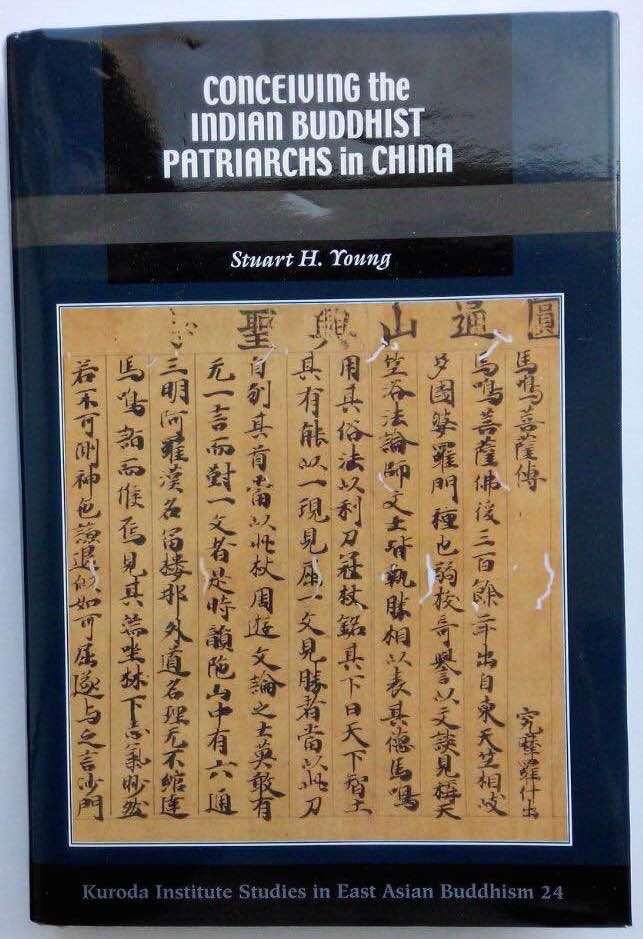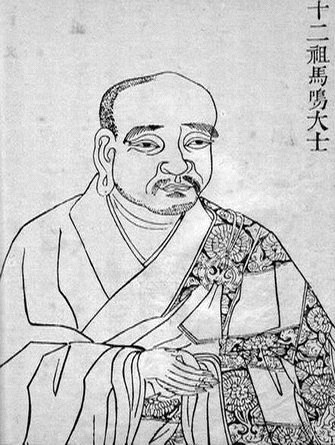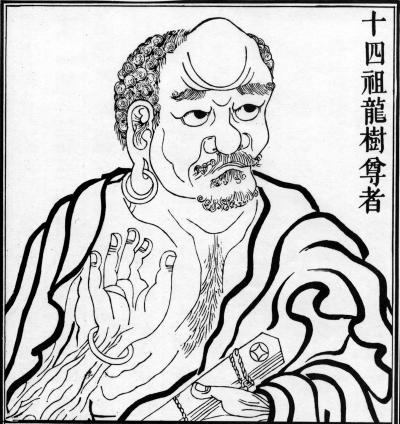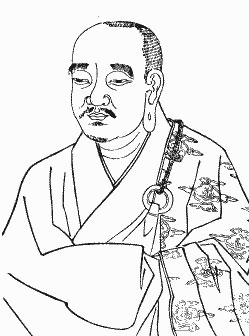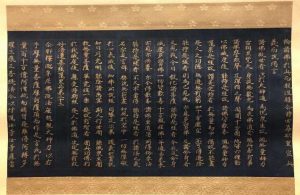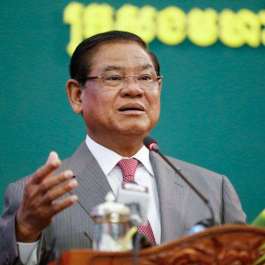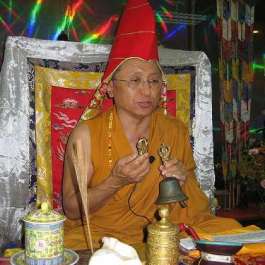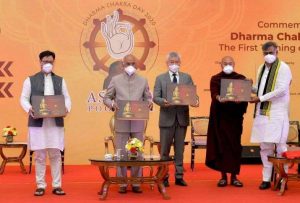It is not always easy to imagine the intentions of those who write hagiography, which is formally defined as the biography of a saint or religious leader. However, in the case of Chinese treatments of Indian masters, hagiography was not merely a means to inspire Chinese Buddhists with the miracle-making and moral power of their Indian spiritual forebears. It was, at its core, a way to redefine models of Buddhist sanctity and legitimize China as an ideal land for the flourishing of Buddhism.
Stuart Young’s new book, Conceiving the Indian Buddhist Patriarchs in China, is the first publication aimed at analyzing the hagiographic imagery of the pre-eminent masters Ashvaghosha, Nagarjuna, and Aryadeva “as it shaped and was shaped by Chinese redactors’ understanding of their own plight as Buddhists in latter-day China” (p. 5). At stake amidst this “plight” was the attempt to Buddhicize Chinese religious repertoires (namely, practices that medieval Chinese audiences would recognize as their own, such as forming master-student lineages, holding court with and counseling emperors, writing philosophy and doctrine, Pure Land devotion, esoteric ritual, and sorcery) and prove the spiritual unity between China and India. Through various means, the hagiographies argued that Ashvaghosha, Nagarjuna, and Aryadeva were Indian exemplars of normative Chinese religious ideals, more concordant with Chinese models of holiness than any of Buddhism’s rivals.
This apparently highbrow and obscure objective should be seen, as all historical events, within a wider context. In the case of the medieval Chinese hagiographies, the texts were in full-blown circulation by the concluding half of the Tang dynasty (618–907). These three founding “patriarchs” (there is no formal term for them) entered the Chinese consciousness through Kumarajiva (344–413 or 350–409) (p. 4) and grew steadily in popularity well into the 10th century, becoming fully accepted into the broader scene of Chinese religion and ritual (p. 219). These centuries coincide with the rise of tantric Buddhism in India, tectonic reconfigurations of economic and geopolitical power across Eurasia, and a wider Chinese attempt to understand their place in the Buddhist cosmos. Indeed, the questions surrounding the Sino-Indian relationship posed nothing less than an existential conundrum for Chinese Buddhists. As with so many historical case studies, the stakes involved in answering such newly arisen questions were much higher than they seem today.
The author is rightly confident that his contribution is different to past monographs about the early Indian patriarchs. The essential difference is that the Buddhist Studies tradition has overwhelmingly concentrated on analyzing Ashvaghosha, Nagarjuna, and Aryadeva in the context of ancient India, using Central Asian, Tibetan, Sanskrit, and some Chinese sources. However, Young argues that the Chinese hagiographies of the three masters are extremely illuminating sources for looking at the development of Buddhism in China (pp. 5–6). His argument is essentially that medieval Chinese authors associated the Indian patriarchs with a diverse repertoire of practices to advance their traditions “as the foremost founts of religious sanctity in medieval China” (p. 13). He covers the various traditions of hagiography that circled in China post-Ashvaghosha up until the late Tang. This book is comprehensive, exhaustive in its detail and nuance, and also a delight to engage in once the stakes are understood.
This immensely detailed study, which deploys argument after argument with textual evidence to back up its central premises, is divided into six chapters. The first, “Buddhist Sainthood in Dharmic History,” charts how Chinese hagiographers attempted to write Buddhist history, which always begins post-Parinirvana, or after the historical Buddha’s death. The Indian patriarchs appear consistently in the writings of Kumarajiva’s associates as salvagers of a decaying Dharma in a world without a Buddha (a situation to which the Chinese were acutely sensitive) (pp. 37–38). Sengzhao (c. 374–414), Sengrui (c. 352–436), and Huiyuan (c. 334–416) in particular advanced the idea that Ashvaghosha, Nagarjuna, and Aryadeva resurrected the Buddha’s lost teachings, crucially through religious repertoires that accorded with the values of “spiritually inclined Chinese literati gentlemen” (p. 21).
The second chapter, “An Indian Lineage Severed,” covers the sources that, in contrast to Kumarajiva and friends’ cyclical vision of a waxing and waning Dharma depending on the appearance and disappearance of holy beings, present the three Indian patriarchs as transmitters of an unbroken Dharma (p. 21). This situated the Indian patriarchs in a linear spiritual
transmission, allowing the sources examined to redefine Buddhist sainthood in terms of a master-to-disciple lineage. The third chapter, “Salvation in Writing and the Annex of Indian Buddhism,” furthers the argument in Chapter 2, analyzing how Sui (581–618) and Tang masters like Xuanzang (602–44) appropriated the Indian patriarchs into broader narratives and religious repertoires to cast China as the center of Buddhist sanctity. Hagiographers of the 7th–9th centuries emphasize Ashvaghosha, Nagarjuna, and Aryadeva’s role as doctrinal expounders, allowing many sectarian schools with their own Sino-Indian lineages to assimilate the patriarchs as their own forebears (p. 22).
There were other resources that could be exploited to localize the three Indian patriarchs. The fourth chapter, “Nagarjuna Divine and the Alchemy of Hagiography,” builds on this idea by illustrating the presentation of Nagarjuna as a master of alchemy, thaumaturgy, and spell-casting (pp. 173 and 179). The hagiographies of these masters cut across sectarian and class lines, suiting the needs of different people at different points in time (p. 283). The fifth chapter, “An Indian Silkworm God in China,” achieves a similar goal by examining how and why Ashvaghosha came to be seen as an Indian deity of silkworms and silk production in the mid- to late Tang eras. This was an ingenious move aimed at making sericulture—one of the most celebrated of Chinese enterprises—a completely Buddhist activity (p. 204).
The final chapter, “Buddhist Saints to Bridge the Sino-Indian Divide,” is a synoptic outline of the dynamics and models Chinese authors used to conceive of the three patriarchs as uniquely Indian-but-Chinese Buddhist saints (my emphasis). Young’s proposal is worth quoting in full: “Chinese authors advanced the Indian patriarchs as post-parinirvana world-saviors who employed traditional Chinese practices, and also as Indian deities who functioned like local Chinese gods. These dynamics further illustrate how models of Buddhist sanctity and salvation were developed in medieval China, and how Buddhist proponents thereby negotiated their identities as representatives of an avowedly foreign religion in China and as Dharma-bearers in a world without a Buddha” (p. 221).
Young has written a groundbreaking book that could revitalize Buddhist Studies scholars’ interest in Buddhist hagiographies. This book will also help historians of China to understand better the role of hagiography in reconciling the spiritual Sino-Indian divide. By analyzing Ashvaghosha, Nagarjuna, and Aryadeva through the lens of Chinese hagiographies, it has helped readers gain a much more sophisticated and holistic understanding of the role that Chinese Buddhists accorded these masters. Also, by providing a multifaceted discussion in six well-argued and thoughtful chapters, readers can understand the broader religious context that stimulated the hagiographers’ motivations.
The Chinese hagiographies of Ashvaghosha, Nagarjuna, and Aryadeva were part of a millennium-old project, dating back to the Han dynasty (206 BCE–220 CE) and aimed at the Sinicization of Buddhism to the point that today, even the Chinese Communist Party praises the faith as “traditional culture” (Reuters). Conceiving the Indian Buddhist Patriarchs in China will enlighten readers to the historical weight of this seemingly everyday statement. It reveals how the status enjoyed by Chinese Buddhism today was by no means guaranteed in medieval times, and that earning it was an exceedingly difficult agenda.
Conceiving the Indian Buddhist Patriarchs in China was published by University of Hawai‘i Press in 2015.
See more
Xi Jinping hopes traditional faiths can fill moral void in China: sources (Reuters)


